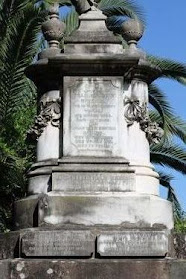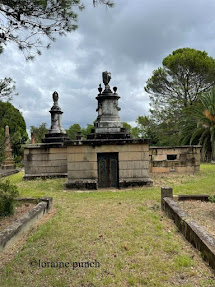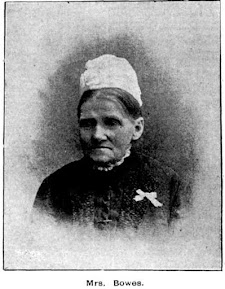A Naval Surgeon who spread his fortune amongst his family
Today's blog is the follow up I promised when I wrote about Nina Eva Vida Jones - the racing car driver (click on the tag of her name to read that blog). I said that she came from a family that included Matthew Harris and his father John (and more) that originated in this country from the early days of the colony.
THE HARRIS FAMILY (pre Nina
Eva Vida Jones nee Harris)
Nina was the daughter of
William Henry Harris and Susan Mary Newton Clarke, both parents of Irish
descent. William came to Australia with his parents John and Nancy Ann and was
the youngest of six children.
John, a merchant, had
inherited wealth from his uncle, a well renown early Colonial, and migrated to
this country to manage his legacy.
That uncle was John Harris,
a member of the NSW Corps, appointed a surgeon who arrived in the Colony with the
ill-fated Second Fleet in 1790. The Second Fleet consisted of three ships where
convicts were mistreated, rations were poor and sickness rife with over 25%
dying on route. In addition, around 80 died within weeks of arrival and many
more within the first year. For the next 10 years Harris worked as a surgeon
and farmer and was even involved in road construction. He then moved into
administration and served as a Police Magistrate for Sydney. He won the
admiration of Governor Philip Gidley King who made him a deputy judge advocate.
Harris seemed to have gotten on the wrong side of some due to his dual role of
advocate and naval officer and when Governor William Bligh took over, he was
dismissed from his position of naval officer leading to great bitterness. This
led to some back-and-forth disputes with Major Johnston and in 1809 he left for
England for two years returning as a married man, soon resigning from Government
posts to be a private settler.
In 1793 Harris was granted
40 hectares in Parramatta and bought a farm from James Ruse that became known
as Experiment Farm. In 1804 he expanded his developments and built a large dwelling
known as Ultimo House near Sydney town with the assistance of Francis Greenway which he subsequently
expanded throughout the years. He lived there for some time, then leased it
out, with family relatives returning later. By the 1830's he developed a hip
problem that confined him to a wheelchair, and he passed away in 1838. He is
buried in St John's cemetery in Parramatta with his wife, Eliza and brother
George.
The Sydney suburb of Harris Park is named after him.
Harris died without issue
and his will gifted significant wealth amongst his family who were mostly in
Ireland. He made an unusual provision that required that some property was to
pass to kin named John "being lawfully begotten and to his heirs male
being so named and lawfully begotten to have and to hold forever."
John left approximately
£150,000 worth of property. Experiment Farm was left to his brother William
Harris' son, Thomas, who bred horses there. He lived at the farm until his death
in 1870, dying ironically of injuries received from a kick from a horse. He is
also buried in St Johns Cemetery at Parramatta.
Nina's father William lived
on the Ultimo estate, in Livingstone House, like a number of his siblings until
his death in 1893. Nina’s grandfather, John was buried in St Johns Cemetery
Parramatta but was exhumed and reburied in the Harris family vault at Rookwood
in 1875.
Nina's uncles Matthew and
John were to make their marks on local politics.
At the age of 21 Matthew,
like his siblings, inherited property including 20 acres on the Ultimo estate
and built a large home. Matthew represented the Denison ward on the Sydney Municipal
Council from 1883-90. He became Mayor of Sydney in 1898, 1899 and 1900 but
faced with a large deficit - including that of the Queen Victoria Building and
allegations that the Council was inefficient - he was unable to introduce
reforms or electric lighting which he advocated. He put forward a plan for a
"Greater Sydney" in which a metropolitan council would replace
existing authorities and be given power to control water supply, sewerage,
traffic, parks, libraries, building regulations amongst others.
Matthew was President of
Sydney Hospital from 1912-17 as well as Vice-President of the Royal
Agricultural Society of NSW as well as others. He was knighted in 1899. He died
in 1917 and was buried in the family vault in the Old Presbyterian area of
Rookwood. Matthew was survived by 8 of his 10 children. HIs family vault also
contains his mother, wife, five siblings and seven of his children.
Another uncle, John Harris,
also represented Denison from 1874-83 and 1886-1911. He became a Magistrate in
1875 and from 1877-80 represented western Sydney in the Legislative Assembly.
He was Mayor of Sydney from 1881-83 and 1888-89. Early in his term in 1881, he
inspected slums condemning many including the Central Police Court. He also
began the reclamation of Blackwattle Bay and resumption of The Rocks and
Darling Harbour but the Council lacked power to do this.
He sat on a number of
Boards, was honorary Treasurer of the Benevolent Asylum and Director of
Randwick Orphan Asylum and Sydney Hospital. He donated his Mayoral allowance to
the University of Sydney for a scholarship in anatomy and physiology. As Mayor,
on the 27th of November 1889, he officially opened the new Town Hall.
John died on the 7th of November 1911 at his home, Bulwarra, from kidney disease and is buried in the
family area in the Old Presbyterian Section of the cemetery. His vault also
includes his wife and two children.
A few years ago, one of the
vaults caved in and another was damaged. There has been work carried out to
repair the damage with only the one with the most damage still requiring repairs.
It appears Nina came from
powerful stock and all resulting from the Naval Surgeon John Harris surviving
the horrors of the Second Fleet back in 1790.
This has been a fascinating
local history lesson; I did know a little, but I have learnt quite a great deal which
just goes to show that Cemeteries are repositories of fascinating facts.
For today's blog I have used
many references - Ancestry.com, Dictionary of Australian Biography for Sir
Matthew Harris and John Harris both written by Martha Rutledge, Find a Grave,
Sydney's Aldermen from the City of Sydney website, the Beecroft-Cheltenham History
Group's information page on the Harris family early history, Wikipedia and
Trove family notices and obituaries.
There are so many more
interesting facts about this family, especially the Colonial Naval Surgeon John
Harris, for which I don’t have the space to fully explore (this blog would
become a novella instead!) but if you have any further insights into the Harris
family, please feel free to add them below or at the Group Facebook page which
can be found under
rookwoodcemeterydiscoveries
or simply send me a personal
message at
lorainepunch@gmail.com
Until next week!













Comments
Post a Comment